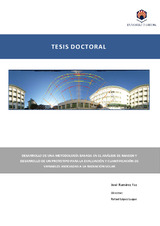Mostrar el registro sencillo del ítem
Desarrollo de una metodología basada en el análisis de imagen y desarrollo de un prototipo para la evaluación y cuantificación de variables asociadas a la radiación solar
| dc.contributor.advisor | López Luque, Rafael | |
| dc.contributor.author | Ramírez Faz, José | |
| dc.date.accessioned | 2013-01-14T17:11:28Z | |
| dc.date.available | 2013-01-14T17:11:28Z | |
| dc.date.issued | 2013 | |
| dc.identifier.uri | http://hdl.handle.net/10396/8627 | |
| dc.description.abstract | La iluminación natural es un factor de calidad ambiental en el uso de los edificios, de manera que el diseño de los mismos y la disponibilidad del recurso solar condicionan su aprovechamiento. Los núcleos urbanos se caracterizan por una alta densidad de edificación, produciéndose obstrucciones de la radiación solar y, por tanto, reduciendo la disponibilidad del recurso. Esta circunstancia se ha venido agravando con el desarrollo urbanístico y ha dado lugar al concepto de “derecho al sol”. Numerosos autores han desarrollado metodologías para la representación de las trayectorias solares observadas desde un punto, destacando entre ellos las cartas solares en las que también se incluyen los elementos que provocan obstrucciones. Se plantea un problema combinado, por un lado se trata de representar la trayectoria aparente del Sol y por otro, la representación del entorno. En general, estas representaciones de una realidad tridimensional se hacen sobre un plano, siendo necesaria la utilización de proyecciones adecuadas para tal fin, si bien se ha generalizado el uso de las proyecciones cartográficas terrestres. La reproducción de bóveda celeste observada desde un punto se suele hacer usando figuras geométricas regulares para representar los edificios y otros elementos, empleando técnicas complejas para la ubicación de los mismos en el espacio. Se justifica el desarrollo de una metodología que permite reproducir la representación de la bóveda celeste de forma precisa y rápida. Una vez se dispone de la bóveda celeste, la cuantificación de las variables solares requiere la utilización de proyecciones específicas, diferentes de las cartográficas terrestres, que resulten equivalentes para el atributo que se quiere analizar. Es objeto de esta tesis el desarrollo matemático proyecciones específicas para cada variable solar, en particular se han desarrollado las correspondientes a la iluminancia en cielos CIE Overcast tipo 1 sobre paramentos horizontales y verticales en representación circular y cilíndrica. 2. Metodología. En Ingeniería y Arquitectura resulta frecuente la necesidad de determinar atributos de un punto directamente relacionados con la bóveda visual. Denominamos atributo integrable a aquel que se puede determinar mediante la integración... | es_ES |
| dc.description.abstract | Daylight is a factor of environmental quality in buildings uses; therefore their designs as well as solar resource availability affect their use. Urban areas are characterized by a high building density, causing obstruction of solar radiation and consequently, reducing the availability of the resource. This situation has been worsening with urban development and has led to the concept of "solar right". Numerous authors have developed methodologies for the representation of sun paths observed from a point, most notably solar letters which also includes elements that cause obstructions. A combined problem arises, in one hand how to represent the apparent solar path and in the other hand, the representation of the sky vault. In general, these representations are three-dimensional reality on a plane, requiring the use of projections suitable for this purpose, although there has been widespread use of terrestrial map projections. Sky vault observed are usually done using regular geometric figures to represent buildings and other elements, employing sophisticated techniques for locating them in the space. This justifies the development of a methodology to accurately and quickly reproduce the representation of the sky vault. Once you have the sky vault, the quantification of the solar variables requires the use of specific projections, different from terrestrial mapping, which are equivalent to the attribute that you want to analyze. The object of this thesis is to mathematically develop specific projections for each solar variable; in particular it has been developed for the CIE Overcast type 1 skies illuminance on horizontal and vertical surfaces, circular and cylindrical representations.Methodology. Engineering and Architecture is often necessary to determine attributes of a point directly related to visual vault. An attribute is integrable if can be determined by double integration... | es_ES |
| dc.format.mimetype | application/pdf | es_ES |
| dc.language.iso | spa | es_ES |
| dc.publisher | Universidad de Córdoba, Servicio de Publicaciones | es_ES |
| dc.rights | https://creativecommons.org/licenses/by-nc-nd/4.0/ | es_ES |
| dc.subject | Radiación solar | es_ES |
| dc.subject | Análisis de imagen | es_ES |
| dc.subject | Evaluación | es_ES |
| dc.subject | Variables solares | es_ES |
| dc.subject | Proyecciones gráficas | es_ES |
| dc.title | Desarrollo de una metodología basada en el análisis de imagen y desarrollo de un prototipo para la evaluación y cuantificación de variables asociadas a la radiación solar | es_ES |
| dc.type | info:eu-repo/semantics/doctoralThesis | es_ES |
| dc.rights.accessRights | info:eu-repo/semantics/openAccess | es_ES |

